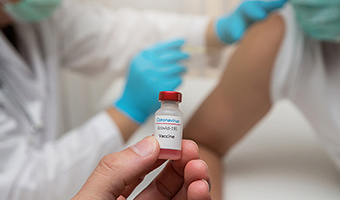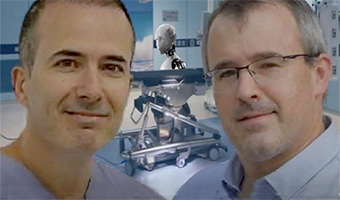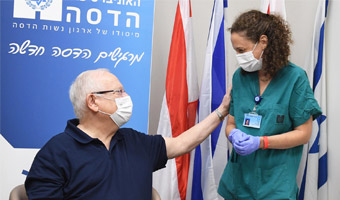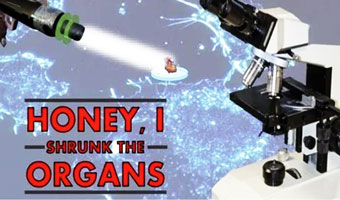Because laughter is magical medicine, the Hadassah University Medical Center has a dynamic Medical Clown Program, which puts a smile on the faces of its pediatric patients.
Introduced in September 2002, Hadassah's Medical Clown Program was the first of its kind in Israel. Clowns are now on hand in the pediatric in-patient and intensive care units, outpatient clinics, acute-care waiting rooms, and the physical therapy, bone marrow transplant, burn, and pediatric AIDS units--easing the stress of serious illness with the healing power of humor. With doses of fun, Hadassah's renowned team of medical clowns helps the children deal with the range of emotions they may experience while in the hospital--fear, anxiety, loneliness, and boredom.
Aside from being professionally trained, the clowns share an intense empathy with children. "I look into a child's eyes and see the person, not the illness," says Jerome, one of the medical clowns. "I don't even think about the illness until I've left the hospital."
According to Prof. Dan Engelhard, head of Pediatrics at Hadassah Hospital-Ein Kerem, the clowns have made "an extraordinary impact" on the Pediatrics Division. "They forge a deep connection with the chronically sick youngsters," he says, "even those who are withdrawn and remote. Once the clowns reach them, it opens the way for the medical staff to do so as well."
The presence of the medical clowns has become a natural part of hospital care at Hadassah. Nurses and doctors call upon the clowns to help the children get through medical procedures such as simple blood tests; the clowns escort children to operating rooms; and they sit with the kids as they receive treatment in emergency rooms or physical therapy. A child can get excited about reaching for a bubble blown by a clown, even if it involves the same movement he or she was resisting moments earlier.
Studies have shown that laughter, just like exercise, can reduce stress, improve tolerance to pain, and alter bodily functions such as blood pressure, heart rate, muscle activity, and stomach acidity. Laughter triggers the release of endorphins and serotonin, the "feel good hormones" that create feelings of euphoria and happiness.
"Clown Tales" from Hadassah
- A pediatrician was losing the battle trying to measure a squirming, wriggling, screaming toddler. Summoned by a nurse, Shlomi, the clown, produced a tape measure of his own and began measuring the doctor while the doctor measured the child, aping the physician's every move. Soon the child was laughing.
- When day after day, a six-year-old patient steadfastly refused to eat, Jerome, the medical clown, was apprised of the problem. He went to see the little boy, and produced a collection of rubber animals. "They're delicious!" he told the child, pretending to eat one up. "Let's have a race, and see who can eat the most." From their competition over the virtual eating of rubber animals, clown and child moved on to real food, and the youngster now eats well--when Jerome is with him.
- Medical Clown Chris walked into the room of a little girl attached to a ventilator. The child lay immobile on the bed, her distressed mother next to her. Chris took a balloon out of his back pocket, blew it up, and started to twist it into a dog. Clowning around, he sometimes fumbled the twists and allowed the balloon to soar, burping out of his grasp. The child's lips quivered into a smile, which became a giggle and then a laugh. "That's the first time she's laughed in six weeks," her gladdened mother told Chris.
- "I try different things until I get it right," says Medical Clown Jerome. "I have a photo of a dog wearing a wig that many children love. I tell them it's my wife." Jerome also takes off his big red clown's nose and puts it on doctors, and this makes the physician seem less fearsome to the children.
Hadassah's Clowns Go Global
When Hadassah's Department of Pediatrics adopted an Ethiopian orphanage and introduced an anti-HIV therapy there, the medical clowns were an integral part of the multidisciplinary team. They are an essential part of many Hadassah teams that respond to international crises around the globe. For example, they flew to Thailand in the aftermath of the 2004 Tsunami and to Haiti after the January 2010 earthquake.
Medical Clown Barashi tells the story of the little girl in Haiti whose crushed leg had to be amputated just above the knee. "The dressing had to be changed," he related, "but the child was in pain and screaming in her language: 'Be careful of my leg!' I went over and repeated her words, as best I could. She stopped struggling and stared at me. I said her words again. And then I chanted them and then began to sing them, mugging around. She giggled and joined in my 'song,' correcting my pronunciation as we sang--and the nurse changed her dressing."
Closer to home, Hadassah's medical clowns provide relief to children in different parts of Israel as the need arises. They traveled, for example, to Northern Israel to bring some comic relief to the children who were traumatized by ongoing rocket fire and the necessity of living in bomb shelters.
"There's nothing as serious as knowing how to make a frightened or suffering child laugh, to separate that child from his pain and fear," Barashi says.









